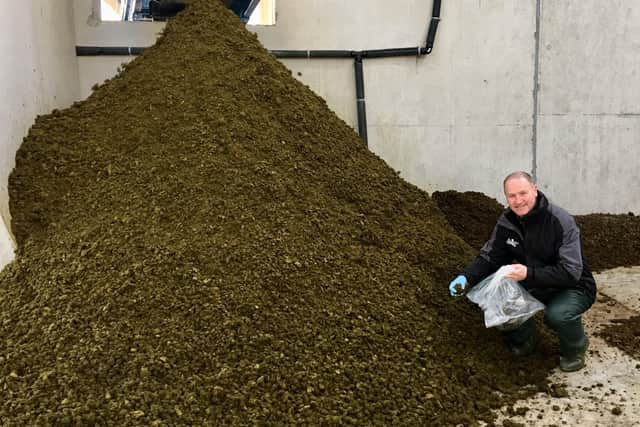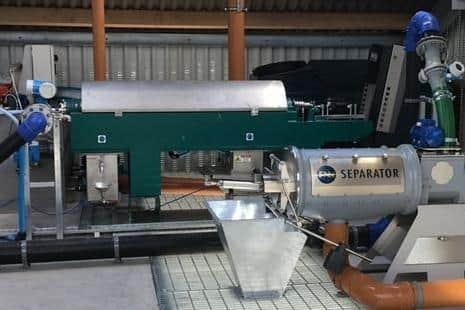Mechanical separation to reduce phosphorus levels in slurry for fields
and live on Freeview channel 276
Hillsborough.
Background: Livestock slurries are useful and valuable sources of plant nutrients. Their uses on farms as fertilisers help close the nutrient cycling loop.
However, in areas with intensive livestock farming systems like those in the dairy sector, the quantities of nutrients available in slurries on a particular farm can exceed the nutrient requirements of grass grown on that farm. Applications of P that are surplus to crop requirements can result in high losses to groundwater and surface water, where eutrophication can cause reduced functioning and biodiversity of aquatic ecosystems and a decline in surface water quality. Many of our most productive and intensive dairy farms have high soil P levels throughout their holding and need to move to a more sustainable position, as they make a vital contribution to agricultural productivity. Technologies are available to separate P from livestock slurries, reducing the P-load applied to agricultural land from these sources and helping to lower environmental risks to water quality. Such treatment technologies, allied with separated solids processing and P export to areas where it is required, would improve the environmental sustainability of dairy farm nutrient management.


AFBI Research
Advertisement
Advertisement
AFBI undertook a comprehensive review of published scientific literature on the effectiveness of these separation technologies to reduce the P loading of slurry and digestate before land application. AFBI also carried out trial work using the Screw Press and Decanter Centrifuge technologies installed at their Farm Nutrient Management Centre at Hillsborough. Both technologies partition a proportion of the insoluble materials (including the P) in slurry in to a separated solids fraction and also produce a separated liquid fraction with lower solids and P content. The research examined capital and operating costs, separation efficiency and throughput, the use of chemical additives, management and processing of separated fractions including transport costs, environmental impacts and the biosecurity of separated solids for export.
Of the two technologies reviewed, Screw Press separation is a more cost effective option when lower amounts of export of P off-farm are acceptable. For farms and those with anaerobic digesters managing larger volumes of manure/digestate, Screw Press separation is possible, however if higher levels of P removal are required, the use of Decanting Centrifugation is a viable option. Centralised processing facilities could also make use of Decanter Centrifuge technology to act as processing hubs for a number of local farms within a distance that makes it economical for transport of slurry/treated slurry to/from the processor. Both separation technologies could be integrated in to agricultural slurry and digestate management systems, to provide a more sustainable approach to managing agricultural P loss and its associated impact on water quality. The research highlighted that Screw Press and Decanter Centrifuge separation could reduce phosphorous content in slurry and digestate separated liquid fractions by up to 34% and from 30 to 93% respectively, depending upon the type of technology deployed and operating conditions. The separated solid fraction could be further processed (anaerobic digestion, composting, drying, pelleting, soil amendment, fuel source) improving the economic feasibility of export distances, or potentially to create a product that could be used locally. However, such processing could be associated with high volatile nitrogen (N) losses and greenhouse gas emissions which may involve the use of abatement technologies to avoid pollution swapping. N losses can also be significantly reduced by acidification of slurries/digestates to pH 5.5. The export of separated solids for better P management is a possible biosecurity issue and precautions may need to be taken to reduce the risks of cross infections caused by pathogenic microorganisms depending upon end use.
Conclusion


Increases in agricultural productivity and production efficiencies must be coupled to reduced impacts if they are to be truly compliant with environmental sustainability in the circular bio-economy. The idea of “climate-smart” agriculture with in-built environmental safeguards is of paramount importance. Mitigation of environmental risks to water quality through adoption of new slurry and digestate management practices, including options for nutrient export off-farm, are key to achieving environmentally sustainable farming systems. Both separation technologies studied result in liquid fractions with reduced solids content so low emission spreading technologies can be deployed, resulting in improved percolation into the soil and better control of the applied N with potential for increased yield relative to untreated slurry, due to higher bioavailable N content and less N loss to the atmosphere.
Over time, application of separated slurry liquid fractions with significantly reduced P content and export from the farm of the solids containing the separated P, should mean that farm P balance is reduced to more manageable levels that minimise environmental impacts.